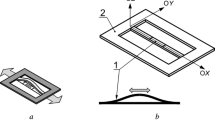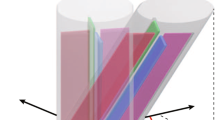Conclusions
The relative sensitivity error of a DST can be reduced only by selecting the materials of strings and elastic elements to have the same temperature coefficients of elastic moduli. The same applies to a SST.
The absolute zero error of a DST can be reduced only by selecting the materials of strings and elastic elements to have the same temperature coefficient of linear expansion. On the other hand, in order to reduce the zero error of a SST it is necessary to pay greater attention to reducing the temperature coefficient of the strings' modulus of elasticity, without excluding the necessity of reducing the difference (α r−α s).
Similar content being viewed by others
Literature cited
Engineer's Handbook [in Russian], Second edition, Vol. 3, Moscow (1954).
G. F. Surkov, “Differential string transducer with steel strings.” Digital Measurement Techniques [in Russian], IZD. ONTIPRIPOR, Moscow (1966), Part. 2.
L. G. Étkin, D. V. Ramm, and D. D. Dorzhiev, Élektroizmeritel'naya tekhnika, No. 4 (1967).
L. G. Étkin, Priborostroenie, No. 12 (1964).
Additional information
Translated from Izmeritel'naya Tekhnika, No. 1, pp. 36–38, January, 1971.
Rights and permissions
About this article
Cite this article
Surkov, G.F. Analysis of the temperature error in a differential string transducer. Meas Tech 14, 55–58 (1971). https://doi.org/10.1007/BF00982245
Received:
Issue Date:
DOI: https://doi.org/10.1007/BF00982245




